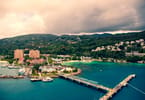It took eight and a half years for AirAsia, which started humbly with just two aircraft and 200 staff, to become the continents’s largest low-cost carrier (LCC) by breaking the 100-million-passenger mark recently.
And the time it will take to reach 200 million will be even shorter. Group chief executive Tony Fernandes reckons that will happen in 2013, which would allow the airline to become Asia’s largest among all carriers in terms of passenger numbers.
Thus, the Malaysia-based budget airline, along with its sister carriers in Thailand and Indonesia, will be working hard to book 50 million passengers annually from 30 million a year now.
“With 30 million [passengers], we are about the fifth largest [overall] in Asia, and if we could get 50 million passengers a year, we will be the largest,” he told the Bangkok Post.
AirAsia’s current annual passenger records are already well above those of leading carriers in the region. For instance, International Air Transport Association statistics show full-service airlines Cathay Pacific carried 18.1 million passengers last year, Thai Airways International 17.9 million, Singapore Airlines 16.3 million and Malaysia Airlines 11.9 million.
The AirAsia group has grown exponentially, much to the concern of legacy airlines in the region, with a fleet of 96 aircraft connecting 22 countries with 139 routes and 8,000 staff.
Looking forward, AirAsia, which wrote a new chapter in aviation history by liberalising air travel with low fares, will continue to expand in mainstream Asia, while Mr Fernandes brushed aside speculation the airline would set up units and grow in other regions.
“That’s not my plan, because there is so much growth here already. I’ve always said grow in your country first, and then expand in your region and then the greater region,” said Mr Fernandes.
“So let’s focus on our own countries [first] – Malaysia, Thailand, Indonesia, Asean and Greater Asia. There are 3 billion people in this region.”
AirAsia has received many proposals to set up LCCs in Europe, the West Indies, Australia and Africa.
“But you know, there is only one me. We’ve got to deliver what we can first [in this region],” said Mr Fernandes.
The airline’s growth will try to to connect much of Asia with its flights over the next few years, he said.
Asked about AirAsia’s future aspirations, Mr Fernandes said: “Very clear. To be the world’s best LCC, to be as good as the economy service of any full-service airline. Second, to be the best company to work for and third to become the largest airline in Asia in terms of passenger numbers and profitability.”
Regarding the emergence of new LCCs in the region, Mr Fernandes said: “Competition will come. Competition is good, the market is big enough, but we’ll deal with it in our normal way. Every time a new airline comes on, we’re much bigger than we were. We dealt with competition when we had only 20 planes; now we have [nearly] 100 planes. So we look forward to it.”
Kathleen Tan, regional head of commercial operations, commented: “You are aware of your competitors, but you don’t let them bother you. You just do what you are good at and focus.”
Meanwhile, Mr Fernandes, now 46, indicated he was pondering retirement, but “not any time soon. I think good leadership is knowing when to go. Leaders, whether in politics or corporations, must be renewed.”






















